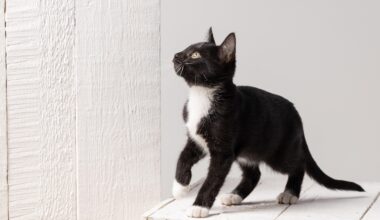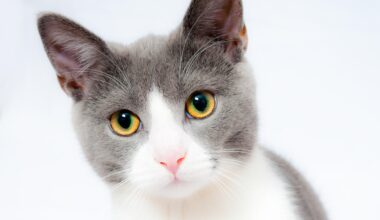Capturing the Softness of Fluffy Cat Fur in Photographs
Cats possess a majestic beauty, and their fur is a divine element that deserves optimal attention during photography. Capturing the intricate textures of cat fur can elevate your photographs from ordinary to extraordinary. The softness of fluffy cat fur creates an engaging visual experience, drawing viewers in to appreciate every hair’s curl and sheen. To accomplish this, one must consider various aspects, including lighting, camera settings, and angles. Use natural light to highlight the delicate details of the fur, allowing the sunshine to dance across the hairs. Additionally, experimenting with different apertures can allow for a striking depth of field, making your subject stand out sharply. Consider photographing at eye level to establish a more personal connection, engaging your audience. Also, be patient as cats often have mind of their own, and it might take time to get that perfect shot. Ultimately, the goal is to portray not just an image, but an emotion, a feeling of warmth evoked by the sight of soft, fluffy cat fur.
Choosing the Right Background for Cat Fur Photography
The choice of background can greatly influence how the textures in cat fur are perceived within your photographs. Opting for a background that complements and contrasts the cat’s fur can enhance the overall composition. For light-colored cats, consider using darker backgrounds that allow the softness and texture of the fur to stand out. Conversely, dark-furred cats can benefit from lighter backgrounds that create a striking contrast, highlighting every unique feature of their fur. Additionally, a simple background minimizes distractions, ensuring the focus remains on your feline subject. Natural settings such as gardens or living rooms can produce beautiful backdrops, with gentle hues accentuating fur textures. Textured backgrounds, like blankets or cushions, can also echo the softness of the fur and add layers to the composition. However, be cautious of overly busy patterns that can detract from the cat’s charm. Balancing your background with your subject is vital in creating a compelling image that emphasizes the furry beauty and exhibits the magnificence of fluffy cat fur.
The right lighting setup is crucial when aiming to capture the soft, fluffy textures of cat fur. Natural light is often the best choice, as it showcases the subtle nuances and gloss of the fur beautifully. Aim to shoot during the golden hour, shortly after sunrise or before sunset, when the light is soft and warm. This golden light enhances the texture, casting gentle shadows that add depth to the fur. If shooting indoors, position your cat near a window where indirect sunlight can illuminate their fur. Avoid harsh, direct sunlight, which can produce undesired shadows and highlights, losing the essence of softness. Experimenting with diffusing materials, such as sheer curtains or softboxes, can help control light intensity. You may even utilize reflectors to bounce light and fill in shadows gently, accentuating the fur’s natural beauty. However, don’t forget to monitor your exposure settings, as varied lighting can influence your shot. Ultimately, the objective is to capture a feeling of fluffiness, warmth, and the intricate beauty that cat fur exhibits.
Camera Settings to Showcase Cat Fur Textures
Understanding camera settings can significantly enhance your ability to capture the detailed textures of cat fur effectively. Start by selecting a wide aperture to reduce your depth of field, thus allowing the fur to emerge sharply against a blurred background. Setting your camera to an aperture of f/2.8 or lower is ideal for focusing on the cat while softening surrounding distractions. A faster shutter speed is essential, especially because cats are naturally curious and can be unpredictable. Utilizing a shutter speed of at least 1/250th of a second lets you freeze moments of their playful antics. Moreover, consider adjusting your ISO settings based on the available light: when shooting in low light, increase the ISO, but remember it can introduce noise. It’s often a balance between capturing detail and minimizing grain. Lastly, don’t overlook the white balance: ensure it reflects the true color of the fur, as inaccuracies can distort the perceived softness and sheen. Knowledge of your camera settings and experimenting with them facilitates your journey in capturing the stunning beauty of cat fur textures.
Engagement with your feline friend during the photography process can yield the most stunning results. Cats are often indifferent to camera presence, so creating a comfortable atmosphere is essential. Use treats, toys, or familiar blankets as props to entice cats into relaxed poses. Interaction and playfulness can help your cat feel at ease, allowing authentic expressions and moments to be captured. Observing their behavior helps you identify angles and situations that work well for your photography. Allowing them to move freely and make choices on where to sit or lie down can lead to spontaneous, candid shots that depict their natural beauty. Patience is key; cats are not always the most cooperative models, yet some of the most striking images stem from quiet moments of serendipity. Incorporate your own personality into the shoot; your enthusiasm can be contagious and encourage your cat to present their best self. Remember that photography should be rewarding for both you and your dear feline, culminating in beautiful images that showcase the enchanting textures of their fur.
Post-Processing Tips for Enhancing Cat Fur Images
After capturing your stunning cat fur images, it’s time to enhance them further via post-processing techniques. Utilizing photo editing software like Adobe Lightroom or Photoshop can help amplify fur textures and colors, making them pop. Begin by adjusting basic settings, such as exposure, contrast, and highlights, to ensure the fur’s natural sheen is adequately represented. Enhancing clarity can allow for the fine details in the fur to show, but be cautious; excessive clarity can create an unnatural appearance. Furthermore, consider utilizing noise reduction features when shooting at higher ISOs to maintain the image quality. Focus on color adjustments, ensuring that fur colors remain true to their real-life counterparts, enhancing vibrancy without oversaturation. Cropping can further refine your image composition, removing distractions and honing in on your feline friend’s fur. Lastly, don’t hesitate to explore various filters or presets for stylistic effects that resonate with your vision. Artistic post-processing is a valuable tool that brings every detail of fluffy cat fur to life, enabling thoughtful compositions.
Sharing your cat photography with the world can foster connections and feedback while showcasing the beauty of feline fur textures. Social media platforms offer significant opportunities to display your work, with communities built around cat photography enthusiasts eager to engage and learn. Instagram is particularly visual, making it a perfect platform to share striking images that highlight the beauty and individuality of different cat breeds and their distinct fur textures. Utilizing relevant hashtags such as #CatPhotography, #FluffyCats, or #FurTextures can help reach a broader audience. Creating a personal blog or website dedicated to your cat photography can establish a portfolio that reflects your unique style and expertise. Sharing insights, tips, and tricks with your audience can grow a dedicated following, promoting discussions about techniques in capturing the beauty of cat fur. Finally, consider participating in local pet exhibitions or online photography contests. Engaging with the community can provide inspiration, perspective, and expert feedback on your journey to mastering the art of photographing cat fur textures.
Conclusion: A Journey of Capturing Cat Fur
The adventure of photographing cat fur textures intertwines technical skills, creativity, and the exploration of natural beauty. Embracing the intricacies of lighting, background choices, and camera settings can transform ordinary snapshots into breathtaking representations of your feline friends. With patience and mindfulness, you can cultivate an environment that encourages your cat to be themselves during the shoot, revealing their soft, fluffy fur’s captivating details. Additionally, post-processing serves as the final touch, allowing your artistic vision to shine while ensuring that you maintain the authenticity of those enchanting textures. Remember to take the time to share your work, as your insights can inspire others on their journey of capturing the magic of cats. Every photograph can tell a story, evoking emotions tied to the unforgettable experiences shared with your furry companions. By immersing yourself in this creative pursuit, the odds of capturing stunning images of cat fur increase dramatically. Ultimately, this journey can lead to discovering the true beauty of cats, celebrating the softness of their fur through the lens of your camera.


